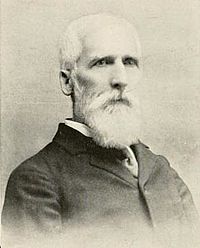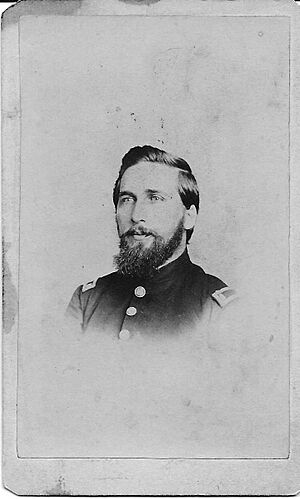Noah Miller Glatfelter facts for kids
Quick facts for kids
Dr. Noah Miller Glatfelter
|
|
|---|---|
 |
|
| Born | November 28, 1837 |
| Died | April 2, 1911 (aged 73) |
| Nationality | American |
| Known for | Contributions to mycology and botany |
| Scientific career | |
| Institutions | Physician |
| Author abbrev. (botany) | Glatf. |
Dr. Noah Miller Glatfelter was an American doctor, family historian, and a keen amateur scientist. He loved studying plants (botany) and fungi (mycology), especially mushrooms. He lived in St. Louis, Missouri from 1867 until he passed away in 1911.
During the American Civil War, he bravely served as a surgeon for the Union Army. After the war, he worked as a private doctor from the 1870s until 1907. Later in life, he became very interested in botany and mycology. In fact, seven different types of fungi have been named after him!
Contents
Early Life and Medical Career
Noah Miller Glatfelter was born on November 28, 1837, in York County, Pennsylvania. He started his education in Millersville, Pennsylvania. He even taught math in Lebanon. From a young age, he was fascinated by nature. He took a geology course and even created a display of rocks and minerals for his school.
In 1862, he began studying medicine at the University of Pennsylvania. He earned his medical degree (M.D.) on March 12, 1864. Soon after, he became an assistant surgeon in the army.
Dr. Glatfelter was present at the Second Battle of Fredericksburg, a major Civil War battle. He worked at various hospitals near Washington, D.C. He even managed a large ship called New World that was turned into a hospital. This hospital ship was 375 feet long! He also served with the Depot Field Hospital of the Army of the Potomac. This hospital was moved four times in just two months, which was an amazing achievement, as it cared for up to 10,000 soldiers.
He married Mary Hegerty on March 23, 1865. After their wedding, he was sent to the Dakota Territory. He stayed there until 1867, when he left the army with the honorary rank of major.
Life in St. Louis
After leaving the army, Noah and Mary Glatfelter moved to St. Louis, Missouri. He started his medical practice in the 1870s. His office was on Salisbury Street. They had seven children: Lisbeth M., Florence May, Edith Edna, Alice Maud Mary, Herbert Spencer, Grace Agnes, and Eva Ethel.
In 1882, Dr. Glatfelter had four houses built on North Fourteenth Street. He lived at one of them. The next year, Fourteenth Street was renamed Twentieth Street, so his address became 4720 N. 20th. He lived in that house for the rest of his life.
Dr. Glatfelter continued to work as a doctor until his wife Mary passed away in 1907. He also did some medical work for charity, helping people who couldn't afford care. He was a member of the Grand Army of the Republic Ransom Post #131. This was a group for Union Army veterans, started by General William Tecumseh Sherman. Dr. Glatfelter was even present at General Sherman's funeral in 1891.
Scientific Contributions
In the early 1890s, Dr. Glatfelter started studying Salix (willow) trees in the St. Louis area. He wanted to find a way to classify different willow species by looking at the patterns of veins on their leaves. He wrote to many famous botanists at Harvard University to share his findings. There is even a willow hybrid named after him, called Salix x glatfelteri.
In 1899, he received a special scientific medal for his important work on willows. This award came from the Academie Internationale de Geographie Botanique.
In the late 1890s, Dr. Glatfelter's interests shifted from plants to fungi, especially mushrooms. His daughter Lisbeth was a member of the Boston Mycological Club, which was the first mushroom club in the United States. This likely sparked his interest. He corresponded with leading mycologists like Curtis Gates Lloyd and Charles Horton Peck. He also met George F. Atkinson at the 1903 St. Louis World's Fair.
Dr. Glatfelter's collection of edible and poisonous mushrooms was part of the Missouri Botanical Garden's display at the World's Fair. He also shared stories of mushroom poisonings from the local area with other scientists. In 1906, he published a list of over 500 types of mushrooms found near St. Louis. This list was later used as a source for a larger checklist of plants and fungi published in 1911.
Seven types of fungi are still named after him today. Some of these names are now considered synonyms, meaning they are different names for the same fungus. Here are some examples:
- Bolbitius glatfelteri Peck
- Collybia glatfelteri Murrill
- Cortinellus glatfelteri Murrill
- Lepiota glatfelteri
Family History and Later Life
Besides his scientific work, Dr. Glatfelter also became a family historian. In 1901, he published a two-volume book called The Record of Casper Glatfelter of Glattfelden, canton Zurich, Switzerland, immigrant, 1743, and of His Descendants. He published a third book in 1910, adding even more families to his family history record.
He continued to collect plant and fungi specimens until 1911. He wanted to update his list for a new publication by the Engelmann Botanical Club.
Dr. Glatfelter passed away on April 2, 1911, after falling from a ladder. He is buried in Bellefontaine Cemetery in St. Louis with most of his family.
Autobiographical Notes
In 1910, Dr. Glatfelter wrote a short note about his life. He mentioned that he was born on November 28, 1837, in York County, Pennsylvania. He lived at 4720 North 20th Street in St. Louis, Missouri. He was the son of Jonathan Glatfelter, a farmer, and Elizabeth Miller.
He left Franklin and Marshall College during his second year to study medicine. He joined the medical school of the University of Pennsylvania in 1862 and graduated in 1864. Then he joined the army as an assistant surgeon. He left the army in February 1867.
He practiced medicine in and around St. Louis for many years. He also spent time on botany, especially researching hybrid willows near St. Louis. He published papers about his findings in science journals. In his later years, he collected many larger fungi around St. Louis. He published a catalog of these fungi through the Academy of Science of Saint Louis, where he was a member.
He married Mary Hegarty in Philadelphia in March 1865. He listed his children as Lisbeth, Florence May (who passed away), Edith Edna, Alice Maud Mary, Grace Agnes (who passed away), Eva Ethel (who passed away), and Herbert Spencer. He noted that he generally enjoyed good health throughout his life.
See also
 In Spanish: Noah Miller Glatfelter para niños
In Spanish: Noah Miller Glatfelter para niños



